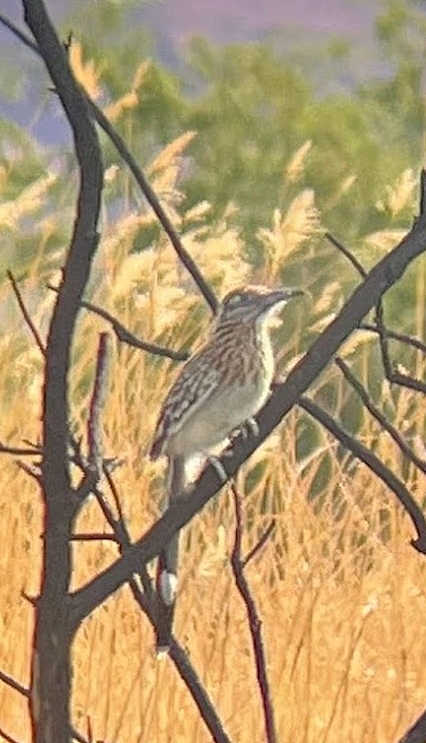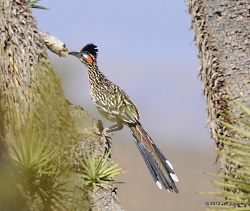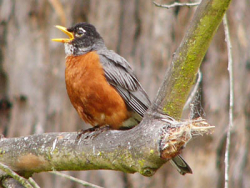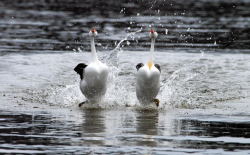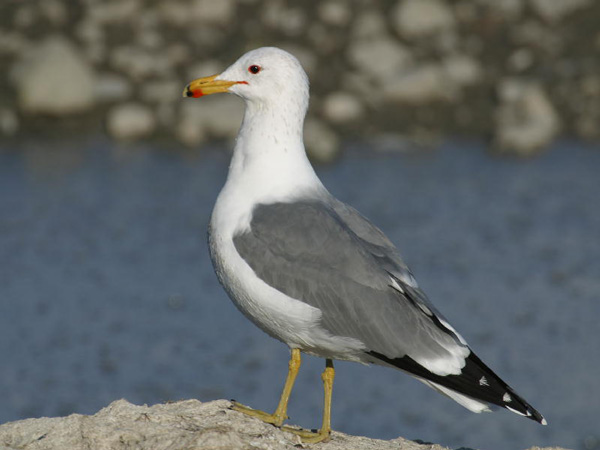
Larus californicus
Courtesy and Copyright 2003 Jack Binch
All Rights Reserved
Utah’s state bird is is commemorated as the seagull, more accurately the the California Gull. Known in Utah for having saved the pioneers from the Mormon cricket invasion of 1848 and subsequent years, gulls hold a hallowed place in local history.
Seagull is a generic term referring to gulls of all types. Gulls we are familiar with range from the small 11-inch Bonaparte’s gull with a 32-inch wingspan to the 20-inch Herring gull with a 55-inch wingspan. They are white, grey and some have black heads. Young go through phases giving them different appearances as they mature over two to four years depending upon the species.
Many Gulls migrate to parts of Utah and some pass through in their migration to more northern regions. Ring-billed gulls are here during the fall, winter, and spring. The occasional Herring or Thayer’s gull may visit us in winter. A few black-headed Bonaparte’s gulls pass through reliably in spring and fall during migration. Upon rare occasions, we are even visited by Herrman’s, Western, Glaucous, Glaucous-winged, Mew, yellow-footed , Sabine’s, Iceland, and lesser black-backed gulls.
In spring, the California gulls and the much smaller and black-headed Franklin’s gulls return to nest. They migrate from southern states or the pacific coast and raise their young locally on islands in fresh and salt water.
Gulls clean up. They frequent garbage dumps, and irrigated, plowed or manure-covered fields. These carnivores eat insects, worms, crustaceans, fish and the occasional french fry in a parking lot. Opportunistic, they watch and raid unprotected nests of other birds, eating eggs and young. Sometimes flying singly, they are more often found in flocks. In flocks they defend against predators by harassment and intimidation.
Thayer’s and Herring gulls have been known to use tools. They have been seen dropping shellfish on asphalt or concrete roads to crack them open and eat the contents.
At the store, take a moment to think about our state bird. In the dump, and in waterways, gulls can become entrapped in six-pack rings. Do your part to prevent this by cutting up these plastic rings before disposing of them. Or better yet, buy cans loose or in boxes instead of rings.
A Moment to Think About Our State Bird: Credits
Photos: Courtesy and © copyright 2003 Jack Binch, as found on www.Utahbirds.org
Text: Bridgerland Audubon Society: Lyle Bingham and Dick Hurren
A Moment to Think About Our State Bird: Additional Reading:
Utah Symbols – California gull
Utah State Bird – Sea Gull(The California gull, Larus californicus), Utah’s Online Library, Utah State Library Division, Utah Department of Heritage & Arts, https://www.utah.gov/about/state-symbols.html
Bonaparte’s Gull, Larus philadelphia
Bonaparte’s gull Larus philadelphia, Patuxent Wildlife Research Center, USGS, https://www.mbr-pwrc.usgs.gov/id/framlst/i0600id.html
Bonaparte’s Gull, All About Birds, Cornell Lab of Ornithology, Cornell University, https://www.allaboutbirds.org/guide/Bonapartes_Gull
Herring Gull, Larus argentatus
Herring gull Larus argentatus, Patuxent Wildlife Research Center, USGS, https://www.mbr-pwrc.usgs.gov/id/framlst/i0510id.html
Herring Gull, All About Birds, Cornell Lab of Ornithology, Cornell University, https://www.allaboutbirds.org/guide/Herring_Gull
Herring Gull(Flying Collection), UtahBirds.org, Utah County Birders, https://www.utahbirds.org/birdsofutah/BirdsD-K/HerringGull3.htm
California gull, Larus californicus
California gull Larus californicus, Patuxent Wildlife Research Center, USGS, https://www.mbr-pwrc.usgs.gov/Infocenter/i0530id.html
California Gull, All About Birds, Cornell Lab of Ornithology, Cornell University, https://www.allaboutbirds.org/guide/California_Gull
California Gull(Adults Collection), UtahBirds.org, Utah County Birders, https://www.utahbirds.org/birdsofutah/BirdsA-C/CaliforniaGull.htm
California Gull(Close-up Collection), UtahBirds.org, Utah County Birders, https://www.utahbirds.org/birdsofutah/BirdsA-C/CaliforniaGull2.htm
Franklin’s gull, Larus pipixcan
Franklin’s gull Larus pipixcan, Patuxent Wildlife Research Center, USGS, https://www.mbr-pwrc.usgs.gov/Infocenter/i0590id.html
Franklin’s Gull, All About Birds, Cornell Lab of Ornithology, Cornell University, https://www.allaboutbirds.org/guide/Franklins_Gull
Thayer’s gull, Larus thayeri
(Note: Reclassified in 2017 as Iceland Gull Larus glaucoides)
Thayer’s gull Larus thayeri, Patuxent Wildlife Research Center, USGS, https://www.mbr-pwrc.usgs.gov/id/framlst/i0518id.html
Iceland Gull (Thayer’s), eBird, Cornell Lab of Ornithology, Cornell University, https://ebird.org/species/thagul
Iceland Gull, All About Birds, Cornell Lab of Ornithology, Cornell University, https://www.allaboutbirds.org/guide/Iceland_Gull
California Gull(Juveniles Collection), UtahBirds.org, Utah County Birders, https://www.utahbirds.org/birdsofutah/BirdsS-Z/ThayersGull2.htm
Handbook of the Birds of the World 3: 609. Lynx Edicions. Larus thayeri (TSN 176828). Integrated Taxonomic Information System. Retrieved on 10 March 2006.
Ring-billed gull, Larus delawarensis
Ring-billed gull Larus delawarensis, Patuxent Wildlife Research Center, USGS, https://www.mbr-pwrc.usgs.gov/Infocenter/i0540id.html
Ring-billed Gull, All About Birds, Cornell Lab of Ornithology, Cornell University, https://www.allaboutbirds.org/guide/Ring-billed_Gull
Mew Gull, Larus canus
Mew gull Larus canus, Patuxent Wildlife Research Center, USGS, https://www.mbr-pwrc.usgs.gov/Infocenter/i0550id.html
Mew Gull, All About Birds, Cornell Lab of Ornithology, Cornell University, https://www.allaboutbirds.org/guide/Mew_Gull
Mew gull(Front Collection), UtahBirds.org, Utah County Birders, https://www.utahbirds.org/birdsofutah/BirdsL-R/MewGull.htm
Glaucous-winged Gull, Larus glaucescen
Glaucous-winged gull Larus glaucescen, Patuxent Wildlife Research Center, USGS, https://www.mbr-pwrc.usgs.gov/infocenter/i0440id.html
Glaucous-winged Gull, All About Birds, Cornell Lab of Ornithology, Cornell University, https://www.allaboutbirds.org/guide/Glaucous-winged_Gull
Glaucous-winged Gull(Adults Collection), UtahBirds.org, Utah County Birders, https://www.utahbirds.org/birdsofutah/BirdsD-K/GlaucousWingedGull.htm
Sabine’s Gull, Xema sabini
Sabine’s gull Xema sabini, Patuxent Wildlife Research Center, USGS, https://www.mbr-pwrc.usgs.gov/infocenter/i0620id.html
Sabine’s Gull(Breeding Collection), UtahBirds.org, Utah County Birders, https://www.utahbirds.org/birdsofutah/BirdsS-Z/SabinesGull.htm
Handbooks & References
Bridgerland Audubon Checklist of Birds, https://www.bridgerlandaudubon.org/checklist.htm
Sibley, David Allen. The Sibley Field Guide to Birds of Western North America ISBN 0-679-45121-8 Bull, John; Farrand, Jr., John (April 1984).
The Audubon Society Field Guide to North American Birds, Eastern Region. New York: Alfred A. Knopf. ISBN 0-394-41405-5.
Andersen, Rebecca, Miracle of the Crickets, Utah Stories from the Beehive Archive, 2011, accessed June 9, 2024, https://www.utahhumanities.org/stories/items/show/223

